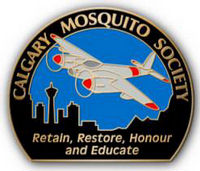

What Did We Do in Q1, 2016?
What follows is a summary of our activities for the first three months of the year, which includes our Annual General Meeting, the completion of our video series and a new record number of volunteer hours invested in our Wooden Wonder
Volunteer Hours
Board members of the Mosquito Society worked a total of 207 hours during the first quarter of 2016 doing, you know…board stuff like board meetings, website updates, report writing, banking, accounting, fundraising, communications, presentations, Facebook promoting, etc.
Members of the society put in 1149 hours on the Mosquito and 143 hours on the Hurricane engine over the same period on 24 separate dates in Calgary and in Nanton.
Volunteer hours for this quarter total 1499. Note that the volunteer hours for the Mosquito are up by 137 over the previous quarter which is a new record high since we began the project.
Hurricane
Historic Aviation Services' focus during the past quarter has been on the engine cowlings and the support structures to which it attaches. We conducted our onsite inspection for this quarter on March 18th.
Airframe: Historic Aviation Services
Centre Section
- Continued repair of radiator scoop assembly.
- Manufactured and installed missing engine mount bolts and hardware using existing examples for pattern.
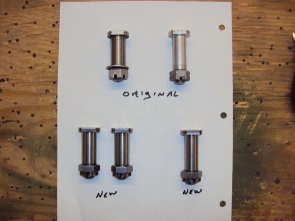
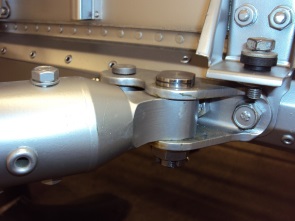
Original and newly manufactured engine truss bolts on left and at right, doing their job.
- Installed, adjusted and secured lower engine mount cross brace wires.
- Cleaned, inspected, repaired as required, primed outer surfaces and sprayed inner surfaces with silver butyrate, Port (2 panels) and STBD side (1 panel) "wing root to lower fuselage" leading edge fairings. Installed same in position on aircraft.
- Fuselage
- Radio tray and battery box frame cleaned, inspected, repaired as required, primed and sprayed with silver butyrate.
- Radio tray and battery box frame installed in position AFT of cockpit.
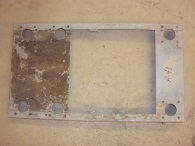
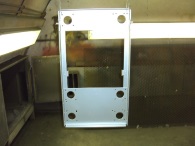
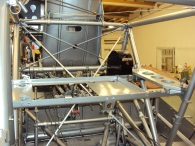
The radio tray: Before, during and installed.
- Finished cleaning, inspection and repair of windscreen support structure and related components, primed and sprayed with silver butyrate and mounted same in position (trial fit).
- Cleaned, inspected, repaired as required and primed front "bullet proof" windscreen framework.
- Installed new glass "bullet proof" panel ("Tombstone") supplied by CMS, in framework and complete assembly fitted to windscreen support structure.
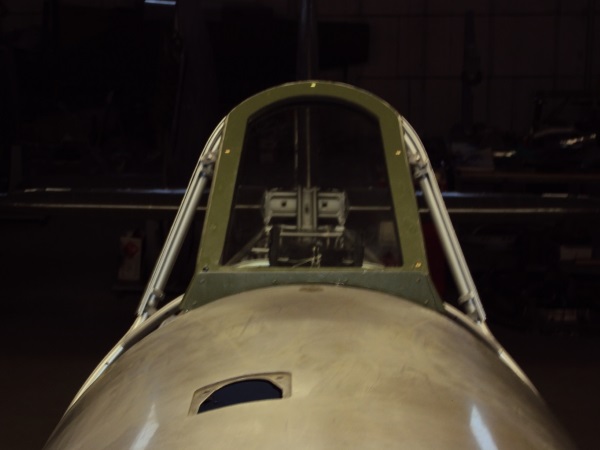
Looking rather menacing, the newly restored windscreen frame with original 1942 Canadian made bullet proof windscreen, acquired in the UK.
- Gunsight reflector panel cleaned, inspected, repaired as required, missing components fabricated, painted matte black, assembled and complete unit installed in position on windscreen support structure.
- Completed repair, primed, sprayed with silver butyrate and installed "port" and "stbd" forward fuselage cowling support "bird cage" structures. Installed same in place.
- Cleaned, inspected, repaired as required, primed outer surfaces, sprayed inner surfaces with silver butyrate, engine "cheek and chin" cowls. Installed same in place.
- Engine front and rear top cowls, cleaned, inspected and installed in place (trial fit) *Note that the upper front cowl is a replacement fabricated during a previous restoration effort and requires major re-work (in progress).

Most of the effort in the past quarter has been on the engine cowlings, supporting frame work and wing to fuselage fairings.
- Sliding canopy section disassembled, cleaned, inspected, repaired as required (requires all new plexi-glass), missing handle and hardware fabricated. Will re-assemble upon acquisition of new plexi-glass kit.
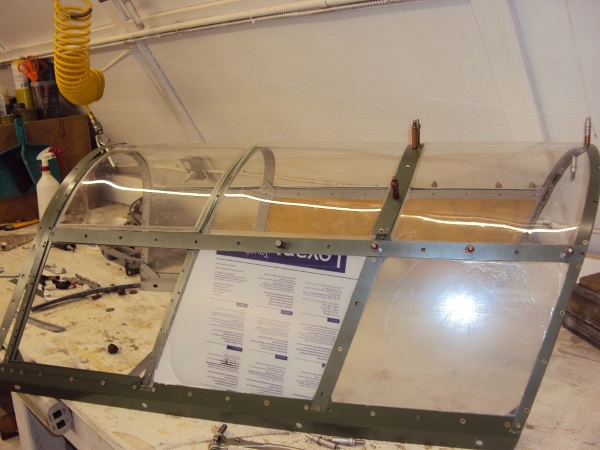
Looking almost new, the sliding canopy frame after disassembly, repair and the installation of all new plexi panels. Still missing handle and hardware.
- Began cleaning and inventory of all secondary engine and systems tubing and lines (coolant, hydraulic, pneumatic). *Note it appears many are missing or damaged.
- Removed port engine "cheek" cowl on Hurricane 5418 to determine information on generator. Unit installed on this aircraft is a "Bendix - Eclipse", 14 volt, 50 amp. A Leese-Neville unit of the same rating could be substituted.
Engine and Parts
Work on the Hurricane's Merlin 29 engine in this past quarter focused on the magnetos, ignition harness and exhaust pipes. As we could find no local vendors to function check the magnetos and harness, we shipped these pieces to Progressive Air Services in Kamloops. All items have been returned and we are now in the process of installing and timing the magnetos.

Paul slowly hand cranks the Hurricane's Merlin while Andy (on his back at the other end) checks timing marks on the front end of the crankshaft.
We are very fortunate in having a complete set of exhaust stubs for the engine as these pieces are quite rare and very valuable. After bead blasting and varsol washing the pipes, we sent the set to Vi-Scan Vision Inspection Services in Calgary for non destructive testing to insure that the pipes were in good shape. They were not. After identifying numerous small cracks in the 74 year old welds and in the material itself, we shipped the exhaust stubs to Acorn Welding in Edmonton for spot repairs. Our thanks to Progressive, Vi-Scan and Acorn for their expertise and valuable donated services.

This model Hurricane sported three exhaust stubs per bank with the forward two having distinctive 'fish mouth' ports. The pipes have been bead blasted, NDT-ed and spot welded.
As was mentioned in our last quarterly report, despite initially agreeing to supply critical missing pieces, Hawker Restoration in the UK has gone silent and declined even to respond to our further queries. Both the CMS and Historic Aviation Services have invested considerable time and energy in sourcing parts and materials elsewhere, with some success. Our efforts have turned up machine shops to replicate some parts, shops and other restoration organizations for others and a complete set of wood part drawings. Still to be sourced is a main hydraulic control valve. What we have is an empty shell. Without it, none of the hydraulic systems will function.
We have not been able to locate any more .303 machine guns and will begin to investigate securing metal replicas.
Mosquito: Jack McWilliam
The canopy frame is now fixed in position to provide more stability to the fuselage, allowing work to commence on damaged areas on the fuselage near the wing's leading edge. The fuselage has been checked for true and no anomalies were found. The canopy frame was attached with both original and replicated parts.
As the fit on our canopy frame seemed to be very poor, a trip to Vancouver was done to confirm the canopy attach points on Bob Jens' flying Mosquito, CF- HMJ. Fifty per cent of our original attach brackets were located. Replica parts were made for the right side which will be used during the repair period. Wooden shims are also installed to stand in for the actual windows so that the fairings can be checked for fit.
Once the canopy was reinstalled, the windshield fairings were fitted with all holes matching to both the canopy frame and the fuselage. As out of alignment as the frame appears, the fairings cover over the very poor fit of the canopy frame. That's just the way they were made.

The canopy frame reinstalled on the fuselage with wood shims and fairings. The fairing covers a number of sins, but mostly the very poor fit of the canopy frame. In his autobiography Sir Geoffrey notes that this was a constant annoyance and a failing in the design of the Mosquito.
Some areas on the canopy frame will require weld repairs, but that will be dealt with after the wood structure is repaired.
The area of the fuselage where the canopy attaches is now being repaired starting on the upper aft area. New pieces are being scarfed in along with the centerline block.
Along with the canopy, the wing attach spar inside the fuselage is being repaired in the area of the attach bolts through hole. Multiple veneers are being clocked and lapped into position with the repair now 90% complete. The stringer below the patch will be splice repaired as the final veneer is applied.

Gary with the four layer patch he made to repair the area around the wing attach bolt through hole.
We have determined the most reliable method of removing skin patches from earlier restoration attempts is to sand the old patch off the aircraft. We have started in the area of the starboard side both at the wing attach spar and in the area where the wing leading edge attaches to the fuselage. This area has a severe fracture in the fuselage and may require both inside and outside skins to be removed.

The circled area is where the fuselage structure is fractured as though it had been dropped or had something heavy dropped on it. As with the area behind the canopy, de Havilland has no structural repair scheme for this part of the airplane as damage in these areas would mean writing off the airplane. We are operating in uncharted territory.
After looking at historic photos of the airplane, we confirmed the location of a second window in the port side aft fuselage that was installed by Spartan for their camera operators. Sanding was commenced both to locate the window and to expose the very poor structural repairs under a section of skin that had been stapled to the fuselage. What we again discovered was that cedar was installed in areas where balsa and spruce had been removed.
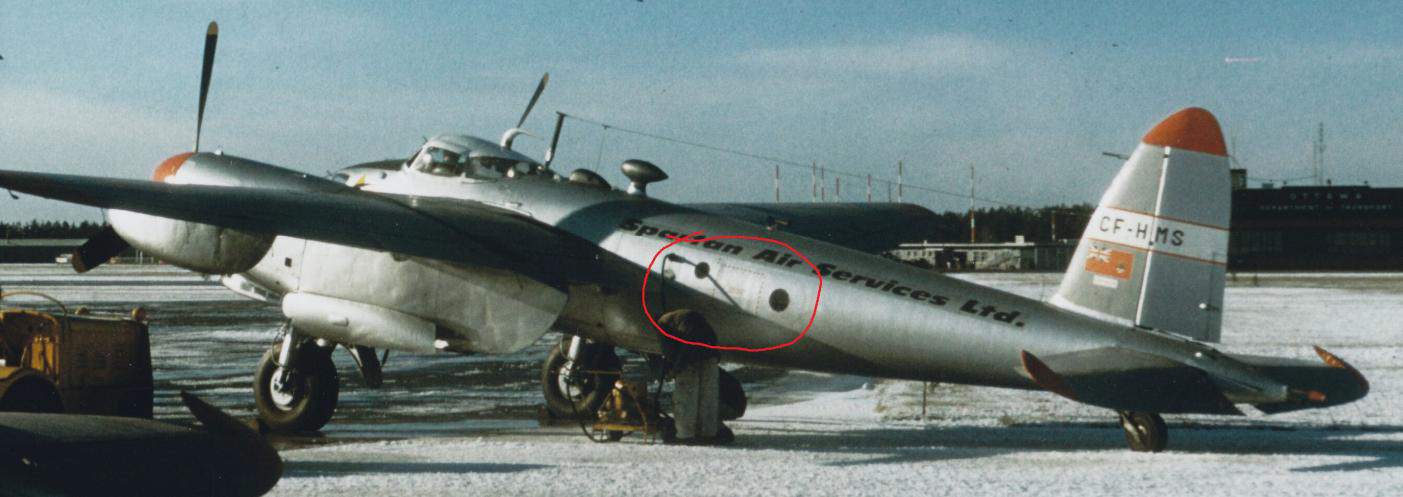
1958 photo showing the Spartan modifications to the rear fuselage. These were added to give the camera operator some natural light. The forward porthole was patched over in a previous restoration attempt.
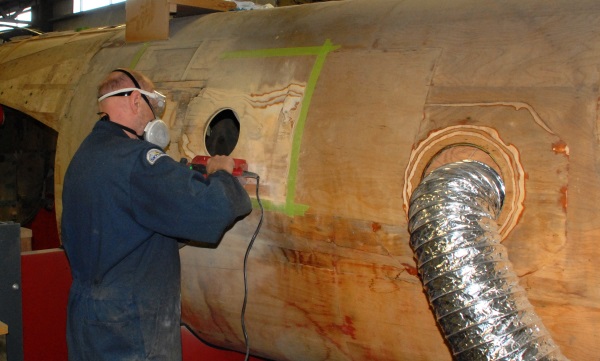
Andy sanding away a patch that covered the porthole. See photo above.
We are also discovering that the skins which have been replaced during an earlier restoration attempt had not bonded to areas where they were in contact with the balsa core. We believe that the skins were only stapled in place and that they had not been clamped after the glue had been applied, resulting in very little adhesion.

Member Rick F., who specializes in cockpit equipment and instrument panels, has added this newest piece, a panel which sits just below the blind flying panel.
To help with the growing collection of hardware and small parts, we acquired a cabinet in which to sort and store a lot of these items.

Sort, store and lock: Our new cabinet.
Displays and Presentations
On the evening of March 16 we welcomed 35 members of the Southern Alberta Woodworkers Society to the Bomber Command Museum for a tour of the Mosquito restoration project. Our VP Jack McWilliam showed the members the work to date, fielded questions and invited members to apply their skills to the project. We'll see if any choose to come on board.
We are looking forward to our host organization, the Bomber Command Museum beginning their summer season opening hours on April 23 with the first of nine special event days which feature Lancaster engine runs, themed events and many hundreds of visitors each day. Through until October, the museum will now be open seven days a week.
As previously mentioned their June 4 special event day is themed around our Mosquito and its 70th anniversary. We have invited historian Robert Stitt to be our key speaker for the day highlighting the history of this airplane and its use by Spartan Air Services. We will also feature live tours of the restoration work and we have created a new display for the occasion with the Wild RC-8 camera.
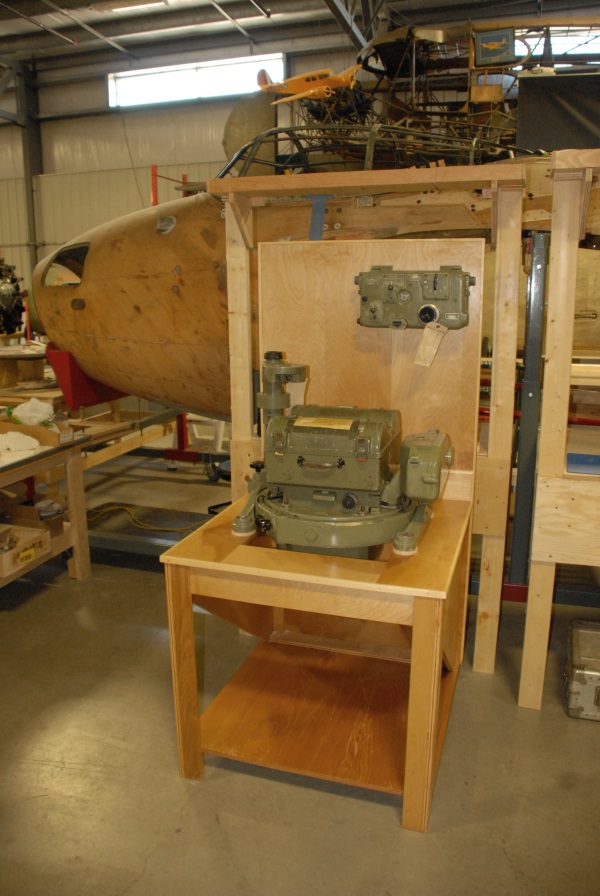
Our original Wild RC-8 aerial camera in its new display stand prepared for the June 4th 'Mosquito Celebration' day event.
As we have done each year, we attended the February 9th organizational meeting for this year's Historic Calgary Week which runs July 22 through August 2.
Over 70 events are staged by thirty participating organizations over the 11 days.
For our part, we will present the history of Calgary's Hawker Hurricane at a noon hour lecture at the Central United Church.
Miscellaneous and In the Works
The CMS held its Annual General Meeting on March 9th at the Phoenix Foundation. The event was well attended and featured a review of the past year's events and a look at future plans. We covered the necessary financial reports and board member selection process.
We said thank you and farewell to board members Ken Pootz, Dr. Stéphane Guevremont and David Dunsmore, the latter two of whom have served since our very first board was convened in 2009. We also welcomed new and very active members to the board, Dick Snider and Don Henderson.
Additionally we launched our annual membership renewal campaign. Membership fees remain at $20. Current paid membership sits at 158.
As promised, Pan Productions have completed their 35 videos to fulfill our mandate to 'Honour' and 'Educate'. Since early March we have been releasing two videos every other day on our YouTube channel and promoting them through our Facebook page and related pages dedicated to the de Havilland Mosquito and Hawker Hurricane. The videos are being very well received and we are proud to be able to honour those whose lives were so intimately entwined with these aircraft in war and in peace.
YouTube: https://www.youtube.com/channel/UCMvwQfjhUSYDt7v9r-64q1g Facebook: https://www.facebook.com/groups/MossieSociety/We had 100 DVD copies produced and are in the process of sending a copy to all of our interviewees. The balance will be offered for sale.
We have filed our final report with our largest funder on this project, the Calgary Foundation and they have asked us to make a presentation to their Funding Committee on April 15. Our initial application to the Calgary Foundation was for $37,500. The Calgary Foundation challenged us to think bigger and upped their contribution to $60,000. The City of Calgary is listed second in the credits on all videos.
Our Q10, 42" touchscreen kiosk has arrived and is now standing adjacent to the Mosquito. All of our videos are loaded and we are just tweaking the programming so that it can run any of the videos from the thumbnail images on the home screen.

Syd Baker now 100 years old, was the chief mechanical engineer for Spartan Air Services and is featured in several of our videos. Already two of our interviewees for this series have passed away. We are very pleased with the work done by Pan Productions and very proud to honour the veterans and the people of Spartan Air Services.
Also in the realm of video work, film maker Alex Robinson has been dropping in on us since the Mosquito arrived in Nanton. In March he spent a day doing some interview work and from it has edited a very professional promotional video that he is now shopping around for funding toward a full length documentary. The promo piece can be seen here: https://www.youtube.com/watch?v=Byoc_b7omLw
The Hurricane too has been getting some attention of late in a newly published book by Gordon Riley about the entire population of surviving Hawker Hurricane aircraft. We of course cooperated with Gordon to detail the history of this airplane and supply him with current photographs.

The City's Hawker Hurricane, RCAF 5389 is featured in this new book by Gordon Riley on the world's complete surviving population of the type. In fact, our bird gets its very own chapter!
We have been working with a CMS member in B.C. who in turn has been working with the model decal company CanMilAir to produce a set of decals for Spartan Air Service Mosquitoes. To aid in these efforts we continue to document the colours and marking that remain on the various components of the Mosquito such as the underside of the wings and the vertical stabilizer and rudder. Examples of the resultant decal sheets can be seen on the CanMilAir website at: http://www.canmilair.com/proddetail.asp?prod=633
As well, the work of our member in B.C. has turned up some incredible results in securing some key missing pieces from our Mosquito. More to follow on that issue.
A project that has been moving ahead in fits and starts for far too long is the production of t-shirt and golf shirts. Three different people have taken it on without success. We finally have a line of shirts featuring the Mosquito and the CMS logo. An additional design is also in production.

Many years in the making, the CMS finally has its own line of t-shirts and golf shirts, featuring the CMS logo and the Spartan Mosquito.

Richard de Boer, President
April 4, 2016
